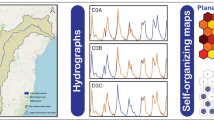Abstract
Flooding due to the increase of heavy rainfall caused even larger damage in metropolitan areas. Therefore, numerical simulation and probabilistic models have been used for flood prediction, but the methodologies for real-time flood prediction by drainage district in metropolitan areas are still not sufficient. In this study, a flood scenario database was established by using one- and two-dimensional hydraulic analysis models to propose a realtime urban flood prediction method by drainage districts in metropolitan areas. Flood prediction models were constructed for each drainage district through the Nonlinear Auto-Regressive with eXogenous inputs and Self-Organizing Map (NARX-SOM). Suggested prediction model is a data-driven model because it is based on flood database which composed with diverse flood simulation results. To evaluate the predictive capacity of the models, flood prediction was performed for the actual heavy rainfall in 2010 and 2011 that caused severe flooding in Seoul, Republic of Korea. Flood prediction models for a total of 24 drainage districts were constructed, and it was found that the goodness of fit on the flood area ranged from 68.7 to 89.7%. In terms of the expected inundation map, the predictive power was found to be high when the SOM result with 5 × 5 dimension was mainly used. Through this study, it was possible to identify the predictive capability of the NARX-SOM flood prediction algorithm. The time for inundation map prediction for each area was within two minutes, but the one- and two-dimensional flood simulation usually takes 60–80 minutes. Moreover, when the calculated goodness of fit was examined, the proposed method was found to be a practical methodology that can be helpful in improving flood response capabilities.
Similar content being viewed by others
References
Akinduko AA, Mirkes EM, Gorban AN (2016) SOM: Stochastic initialization versus principal components. Information Sciences 364:213–221
Bertsch R, Glenis V, Kilsby C (2017) Urban flood simulation using synthetic storm drain networks. Water 9(12), DOI: https://doi.org/10.3390/w9120925
Cea L, Garrido M, Puertas J (2010) Experimental validation of two-dimensional depth-averaged models for forecasting rainfall-runoff from precipitation data in urban areas. Journal of Hydrology 382:88–102
Chang FJ, Chang LC, Wang YS (2007) Enforced self-organizing map neural networks for river flood forecasting. Hydrological Process 21(6):741–749
Chang FJ, Chen PA, Lu YR, Huang E, Chang KY (2014a) Real-time multi-step-ahead water level forecasting by recurrent neural networks for urban flood control. Journal of Hydrology 517:836–846
Chang LC, Shen HY, Chang FJ (2014b) Regional flood inundation nowcast using hybrid SOM and dynamic neural networks. Journal of Hydrology 519(Part A):476–489
Domingo ND, Refsgaard A, Mark O, Paludan B (2010) Flood analysis in mixed-urban areas reflecting interactions with the complete water cycle through coupled hydrologic-hydraulic modelling. Water Science & Technology 62(6):1386–1392
Granata F, Gargano R, Marinis G (2016) Support vector regression for rainfall-runoff modeling in urban drainage: A comparison with the EPA’s storm water management model. Water 8(3), DOI: 10.3390/w8030069
Huber WC, Dickson RE (1988) Storm water management model. User’s manual, version 4. US Environmental Protection Agency, Athens, GA, USA
Jhong YD, Chen CS, Lin HP, Chen ST (2018) Physical hybrid neural network model to forecast typhoon floods. Water 10(632), DOI: https://doi.org/10.3390/w10050632
Jhong BC, Wang JH, Lin GF (2016) Improving the long lead-time inundation forecasts using effective typhoon characteristics. Water Resources Management 30:4247–4271
Kang JE, Lee MJ (2015) Analysis of urban infrastructure risk areas to flooding using neural network in Seoul. Journal of the Korean Society of Civil Engineers 35(4):997–1006
Kim HI, Keum HJ, Han KY (2018) Application and comparison of dynamic artificial neural network for urban inundation analysis. Journal of the Korean Society of Civil Engineers 38(5):671–683
Kim HI, Keum HJ, Han KY (2019) Real-time urban inundation prediction combining hydraulic and probabilistic methods. Water 11(2), DOI: https://doi.org/10.3390/w11020293
Kisi O, Cimen M (2011) A wavelet-support vector machine conjunction model for monthly streamflow forecasting. Journal of Hydrology 399:32–140
Liong SY, Chan WT, Ram SJ (1995) Peak flow forecasting with genetic algorithm and SWMM. ASCE Journal of Hydraulic Engineering 121(8):613–617
Seoul Metropolitan City (2015) Comprehensive plan for storm and flood damage reduction. Soul Metropolitan City, Seoul, Korea
Shen HY, Chang LC (2013) Online multistep-ahead inundation depth forecasts by recurrent NARX networks. Hydrology and Earth System Sciences 17:935–945
Shu C, Burn DH (2004) Homogenous pooling group delineation for flood frequency analysis using a fuzzy expert system with genetic enhancement. Journal of Hydrology 291:132–149
Tsakiri K, Marsellos A, Kapetanakis S (2018) Artificial neural network and multiple linear regression for flood prediction in Mohawk river, New York. Water 10(9), DOI: https://doi.org/10.3390/w10091158
Vojinovic Z, Tutulic D (2009) On the use of 1D and coupled 1D-2D modelling approaches for assessment of flood damage in urban areas. Urban Water Journal 6(3):183–199
Wu MC, Lin GF, Lin HY (2014) Improving the forecasts of extreme streamflow by support vector regression with the data extracted by self-organizing map. Hydrological Process 28:386–397
Acknowledgements
This work was supported by Korea Environment Industry & Technology Institute (KEITI) though Water Management Research Program, funded by Korea Ministry of Environment (MOE) (79609).
Author information
Authors and Affiliations
Corresponding author
Rights and permissions
About this article
Cite this article
Kim, H.I., Han, K.Y. Data-Driven Approach for the Rapid Simulation of Urban Flood Prediction. KSCE J Civ Eng 24, 1932–1943 (2020). https://doi.org/10.1007/s12205-020-1304-7
Received:
Revised:
Accepted:
Published:
Issue Date:
DOI: https://doi.org/10.1007/s12205-020-1304-7




